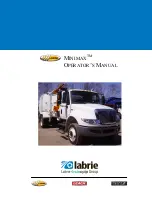
BRAKES 5B-48
2. Place button on plunger shaft, line up hole
in button with hole in plunger shaft and drive in
spirol pin.
3. Connect air lines to push-pull control valve
ports making sure lines are connected to correct
ports.
4. Build up vehicle air pressure system, and
check valve for operation and leaks.
SYNCHRO VALVE
The purpose of the Synchro valve is to activate
the trailer emergency brakes when tractor emerg
ency push-pull control valve is pulled. It joins the
trailer emergency brake system to the tractor
parking and emergency brake system. It is used
only on vehicles which have trailer brake connec
tions and air operated emergency brakes (TG,
TM-70 only).
On tractors which have an air operated em er
gency brake system (such as DD3), as opposed to
those having a mechanically applied emergency
brake, this valve is used to apply both tractor and
trailer emergency systems simultaneously. The
basic purpose of this type application is to prevent
trailer "jack-knife” conditions, which can result
from applying only tractor brakes while vehicle is
in motion.
The Synchro valve is mounted in the air line
system controlling the trailer emergency valve. It
is installed in the lines at the cab front cross sill,
in or near the junction block in the sill. It is ac
cessible with cab tilted or from underneath with
cab in normal position. The supply of air from the
Synchro valve is connected to the control port of
the tractor protection valve.
SE R V IC E A B ILIT Y T E ST S
1. Operating Test. Pull knob of push-pull con
trol valve (tractor emergency brake) and note that
trailer emergency brakes also apply. Push knob of
push-pull control valve and note that trailer emerg
ency brakes release. A 100 psi foot valve brake
application will be necessary to complete release
of tractor brakes.
2. Leakage Test. Using soap suds, check for
leakage both with brakes applied and released. If
any leakage is evident, remove valve from vehicle
and repair or replace.
R E P L A C E M E N T
Removal
1. Block vehicle wheels or make a parking
brake application (with DD3 system, parking brake
is effective after air is exhausted).
2. Exhaust air from brake system.
3. Disconnect air lines from synchro valve
and remove valve.
Installation
1. Place valve in position and connect air lines.
2. Start engine and build up air pressure to at
least 100 psi.
3. Push "in" on control valve knob and make
a service brake application. This will release the
parking brake application.
4. Test as directed in applicable procedure.
FRONT BRAKE SHOES AN D ANCHOR PINS
Wagner front brakes are standard on all
models.
Rockwell front brakes are used on
F-160 axle which is used as optional equipment
on JM-80 models.
W A G N E R BRAKES (Fig. 19)
Anchor pin ends of shoes are secured on
anchor pins by lock rings. Shoe ends are not equip
ped with bushings; if shoes or anchor pins become
worn, parts must be replaced. Contact between
cam ends of shoes and cam is made through roll
ers. No lubricant should be applied at rollers or
cam head; anchor pin ends should be coated with
S-17 Special Lubricant or equivalent at assembly.
Guide pins, two for each shoe, hold shoes in align
ment on backing plate.
R O C K W E L L BRAKES (Fig. 20)
Models Equipped with Optional F-150 or F-160
Axle (Fig. 20). Front brake shoes are retained on
adjustable eccentric type anchor pins by C-wash-
ers. Anchor pin ends of shoes are equipped with
replaceable bushings. C am end of each shoe is
flame hardened at surface in contact with cam.
A L L M O D E L S
One-piece molded lining is riveted to each
CHEVROLET SERIES 70-80 H EAVY DUTY TRUCK SH O P M A N U A L
Summary of Contents for 70 1969 Series
Page 1: ...CHEVROLET HEAVY DUTY TRUCK SHOP MANUAL...
Page 3: ......
Page 11: ...LUBRICATION 0 4 CHEVROLET SERIES 70 80 HEAVY DUTY TRUCK SHOP MANUAL...
Page 27: ......
Page 119: ......
Page 361: ......
Page 371: ......
Page 427: ......
Page 443: ......
Page 451: ......
Page 493: ......
Page 499: ......
Page 549: ......
Page 555: ......
Page 609: ......
Page 715: ...am...
Page 745: ......
Page 910: ......
Page 913: ......









































